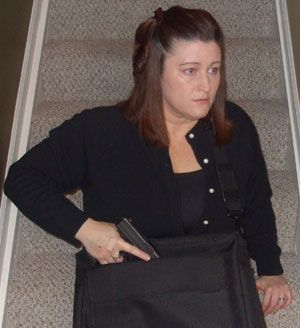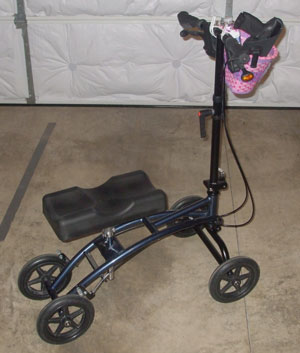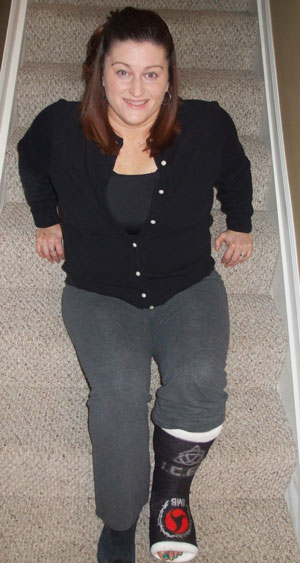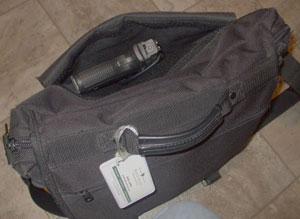 Life throws us the occasional curveball. Circumstances beyond our control can compel us to change the way we do things, and these changes can manifest themselves in any aspect of our day-to-day activities, including our self-defense strategies.My family and I recently encountered one of these curveballs. Although it was a relatively minor and temporary situation, it required a significant adjustment to some of our personal protection plans, training and equipment. Because of this, I wanted to share the experience with everyone here on the Personal Defense Network.It started simply enough, when my wife Julie took a single step to the left while training in a defensive knife class. That step aggravated an existing but unrecognized stress fracture, resulting in a Jones’ fracture of the fifth left metatarsal. Or to put it in my level of medical knowledge, she broke her foot.While not an uncommon event, it does require a corrective surgical procedure and, more important to our topic, weeks without normal use of the foot or leg. This led to some highly modified behaviors. In a nutshell, it raised the question of how can we defend ourselves while hobbling around in a fiberglass cast? It was more work than either of us had anticipated.The infamous scooter, with basket and holstered pistol.
Life throws us the occasional curveball. Circumstances beyond our control can compel us to change the way we do things, and these changes can manifest themselves in any aspect of our day-to-day activities, including our self-defense strategies.My family and I recently encountered one of these curveballs. Although it was a relatively minor and temporary situation, it required a significant adjustment to some of our personal protection plans, training and equipment. Because of this, I wanted to share the experience with everyone here on the Personal Defense Network.It started simply enough, when my wife Julie took a single step to the left while training in a defensive knife class. That step aggravated an existing but unrecognized stress fracture, resulting in a Jones’ fracture of the fifth left metatarsal. Or to put it in my level of medical knowledge, she broke her foot.While not an uncommon event, it does require a corrective surgical procedure and, more important to our topic, weeks without normal use of the foot or leg. This led to some highly modified behaviors. In a nutshell, it raised the question of how can we defend ourselves while hobbling around in a fiberglass cast? It was more work than either of us had anticipated.The infamous scooter, with basket and holstered pistol.
Mobility Inside the Home
The first problem we had to consider was inside our house. Julie was home while I was at work. During this time, she was almost totally reliant on a small four-wheeled cart for mobility. Since the cart had to go wherever she went, the best solution presented itself without much difficulty. The cart (henceforth known as “the scooter”) was rented from a medical supply store and proved to be an absolute godsend for getting around the house.
However, it had a couple of drawbacks, most importantly that it lacked any cargo capacity. This made even simple tasks more complicated. Noticing this defect, a neighbor (with a sense of humor) attached a small pink bicycle basket to the handlebars. Now Julie could move about with a small quantity of essentials in the basket. An inexpensive generic inside-the-waistband holster, rescued from my stash of orphaned gun stuff, easily attached to the basket and provided ready access to Julie’s XD9 pistol. The basket also kept her cell phone handy, along with more mundane necessities.
The scooter’s other shortcoming is that we live in a two-story house. It just wasn’t possible for Julie to drag the scooter upstairs if that is where she needed to go. So the imperfect solution was for her to keep a pair of crutches at the top of the stairs. Julie could dismount the scooter at the foot of the stairs, crawl to the top and use the crutches while on the second floor. In order to have her gun and phone with her, Julie took to wearing a pullover fleece with a large handwarmer front pocket while at the house by herself. It was, of course, helpful that it was the dead of winter in Ohio and wearing the fleece indoors was no problem!
This aforementioned crawling up the stairs took a couple of different forms, but Julie eventually decided that the preferred method was to sit on a step, facing away, and use her arms and right leg to lift herself up to the next step. Although it resulted in her going up the steps backward, this was a good position to access the phone or pistol, and was a bit of an upper body workout as well. It also came in handy when facing the next, and much more difficult, situation: self-defense outside the home.
At Work
Because the injury was to her left foot, Julie was able to continue driving her little automatic transmission Toyota and was only waiting for the doctor’s OK to go back to work. And that provided a number of challenges.
First, she works for a company where she makes up exactly 50% of the total population, and 100% of the full-time office staff. That means there isn’t much opportunity for sharing a ride or having a co-worker help her around. The office building doesn’t make things any easier — it has handicapped access but nothing that helps Julie while she is on her crutches. In fact, reaching the front door requires negotiating eight concrete steps. Once inside, it’s another 14 steps down to the office, located on the below-ground-level first floor. A rear entrance is only six steps down but is an absolute blueprint for the kind of area in which we don’t let ourselves or our loved ones find themselves: isolated, with high privacy fences, surrounded by trees, no witnesses in view … and no way out. So the front entrance was the only real option.
The bad news was that it is a long haul up the front steps. The good news was that by vaulting step-by-step backward, Julie was facing toward the parking lot, the likely origin of an attack. But this caused another problem in that she would be wearing a coat that extended well below her waist. Good for keeping the hindquarters warm and dry but makes reaching a holstered pistol pretty well impossible. The next challenge was how to carry the XD9 so that it could be accessed from this less-than-ideal position, with crutches in tow, on a freezing winter day.
Gun Gear to the Rescue
Once again, it was our (my) extensive collection of homeless gun stuff that provided a workable solution, this time in the form of an Uncle Mike’s concealed-carry briefcase. The shoulder strap is fully adjustable and, unlike many purse options, is long enough for Julie to swing the bag across her chest and rest it on her lap.
The case itself is well thought out and served as a combination portable office and cargo carrier. It has plenty of pockets, pencil slots, dividers and, most importantly, a rectangular gun pocket lined with Velcro that allows nearly limitless configurations for the included nylon holster. The gun pocket forms the back wall of the bag and has a narrow reach-through slot held closed by just a tiny Velcro tab. If a potential threat approached at the most inopportune moment, Julie could reach either hand straight down and get to the gun.
Training and Practice
Of course, equipment is only half of the equation — the other component is training. These imperfect solutions were made viable mostly because Julie trains and practices her self-defense skills regularly. Drawing a pistol from a satchel hanging around your neck is not easy under any circumstances, but it’s much more within reach if you already practice presentation from a holster on a regular basis.
Adjusting Julie’s routine also took into account her previous martial-arts experience. An injury to the leg or foot obviously ruins normal mobility, so going to, and fighting from, the ground are real possibilities. Having some ability and training in this realm helped Julie form her overall plan — using weapon skills that can turn a humble pair of crutches into formidable defensive weapons, or the fact that her letter opener bears a startling likeness to an Emerson Karambit. So she created a multi-layered system based around the idea of defending herself while tied down by her injured foot. Julie tried out a few different ideas and put into use those that seemed the most practical. We discussed how much different things would be if it were an arm in a sling, or a wheelchair and not a scooter or pair of crutches.
In the end, it’s not the details of how Julie coped with carrying her gun during a temporary disability that are important. What’s important is that, with our combined years of teaching, training and thinking about self-defense, neither of us had ever considered how easily a simple change in physical circumstances could screw up our plans. And that is why I thought this article could be of some value – a reminder that our day-to-day comfort zones can be turned upside down without warning. But with a little thinking ahead, the disruption caused by injuries, accidents, unexpected surgeries, and other unwelcome events can be held to a manageable minimum. And after all, isn’t keeping challenging circumstances down to a manageable minimum a pretty good definition of “self-defense”?






How does a man over 70 train for self defence. Like Julie, mobility is limited. I go to the range every week, only to shoot 25-30 rounds to maintain gun control. What else should I be doing. In advance Thanks
I really found this interesting, particularly since I am right dominant and I broke my right arm about 3 inches below the shoulder. I didn't get a cast, but I did get at least 6 hours of major surgery and a sling. I worked as a legal secretary and my boss would try to hand me 5 inch thick files that I just couldn't carry because he was forgetful of my injury. Getting the use of my right arm back took quite some time. The journey you and Julie took together in figuring out how to manage the circumstances is awesome! I realize that with what happened to me it really is important to learn to use my left hand as well as I can use the right. Thank you for writing this and sharing.